Art & Exhibitions
David Ebony’s Top 10 Most Memorable Artworks of 2015
The overheated art world spawned some unforgettable works.
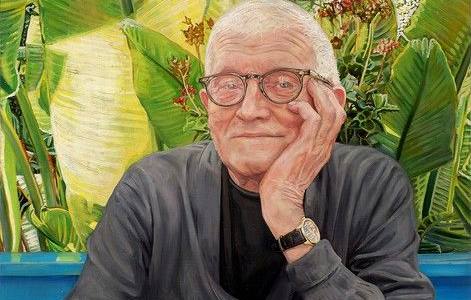
The overheated art world spawned some unforgettable works.

David Ebony

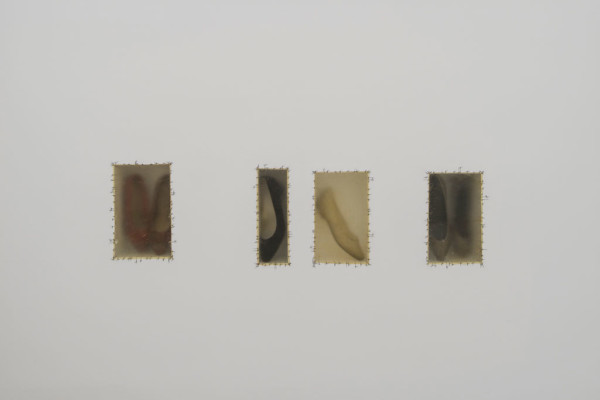
Doris Salcedo, installation view.
Image: Courtesy of Guggenheim Museum, New York.
The hyper-energized and overheated art world of 2015 spawned some unforgettable works in all mediums.
Here are just a few examples, not all produced this year, but seen for the first time in 2015. Some works remain on view into 2016, which is good for those with busy schedules.
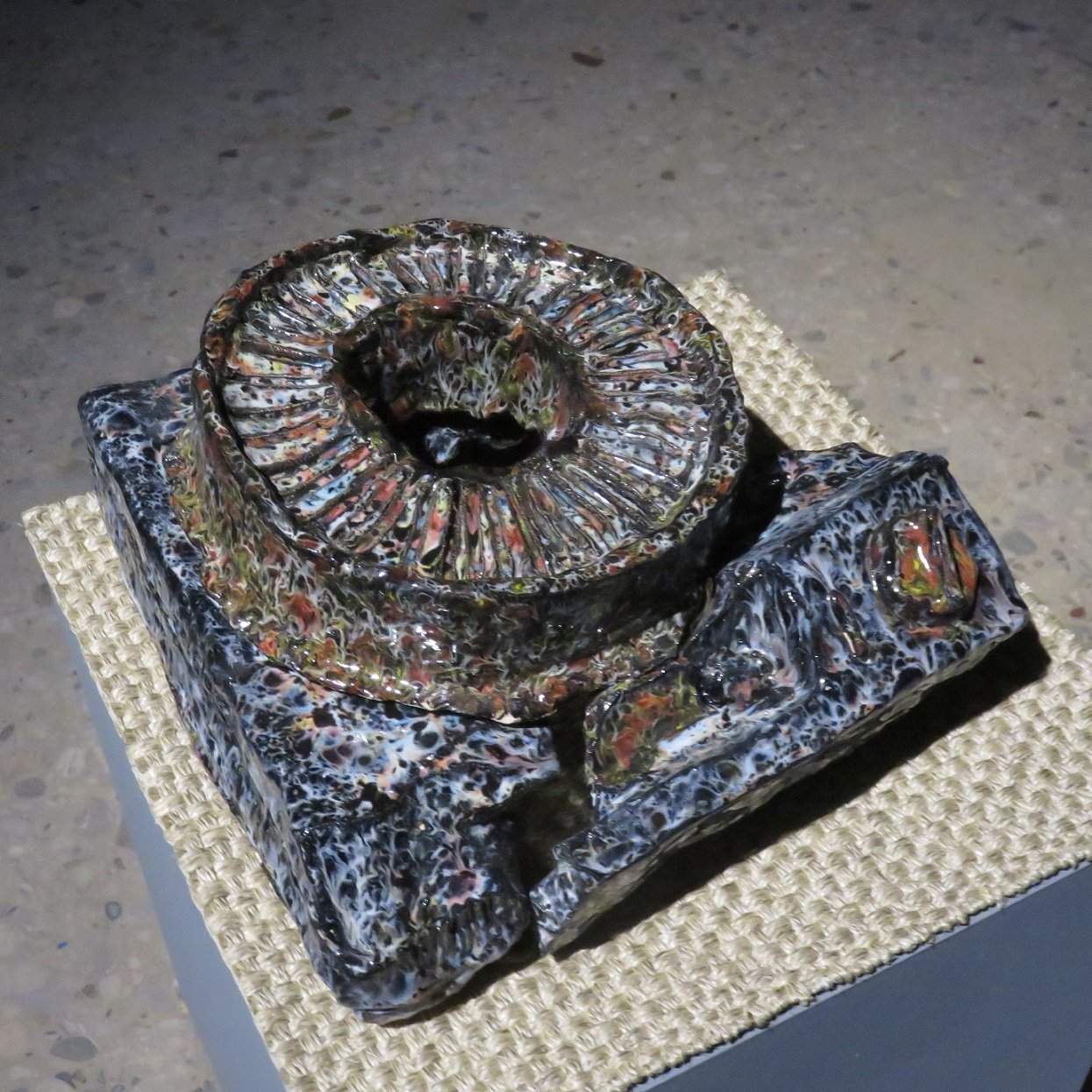
Trisha Baga, ceramic slide projector, part of the installation Orlando, 2015.
Photo Courtesy the artist and Greene Naftali.
1. Trisha Baga, Orlando (2015)
I felt very lucky to have experienced Orlando this fall, far ahead of its time. Trisha Baga conceived the mutifaceted installation, at New York’s Greene Naftali in September, as an exhibition that takes place far in the future, when peacocks are the dominant species. Say what?! Sure enough, spanning one wall, a 3-D video projection, Peacock Museum: The Department of Education, showed live peacocks pecking at large portraits of Ellen DeGeneres and Rosie O’Donnell rendered in bird seeds. The exhibition’s title refers to both Virginia Woolf’s famous novel, and the Florida city, which, in Baga’s hallucinatory vision, is the last major metropolis standing after the Big Thaw has inundated much of the world.
Somehow, the New York-based artist made everything in this outlandish show seem logical, credible, and profound. Often both hilarious and alarming, the exhibition featured a number of other video works and sculptural objects, reflecting Baga’s feverish creativity and wild imagination. Especially unforgettable were the recent ceramics, in which familiar objects like cameras, Statue of Liberty souvenirs, and bags of taco chips seem to have suffered a nuclear meltdown. My favorite was a vivid though abject life-size glazed ceramic rendering of a slide projector that could be an archaeological find of the future, spot-lit here as if in a museum of long-forgotten technological oddities.
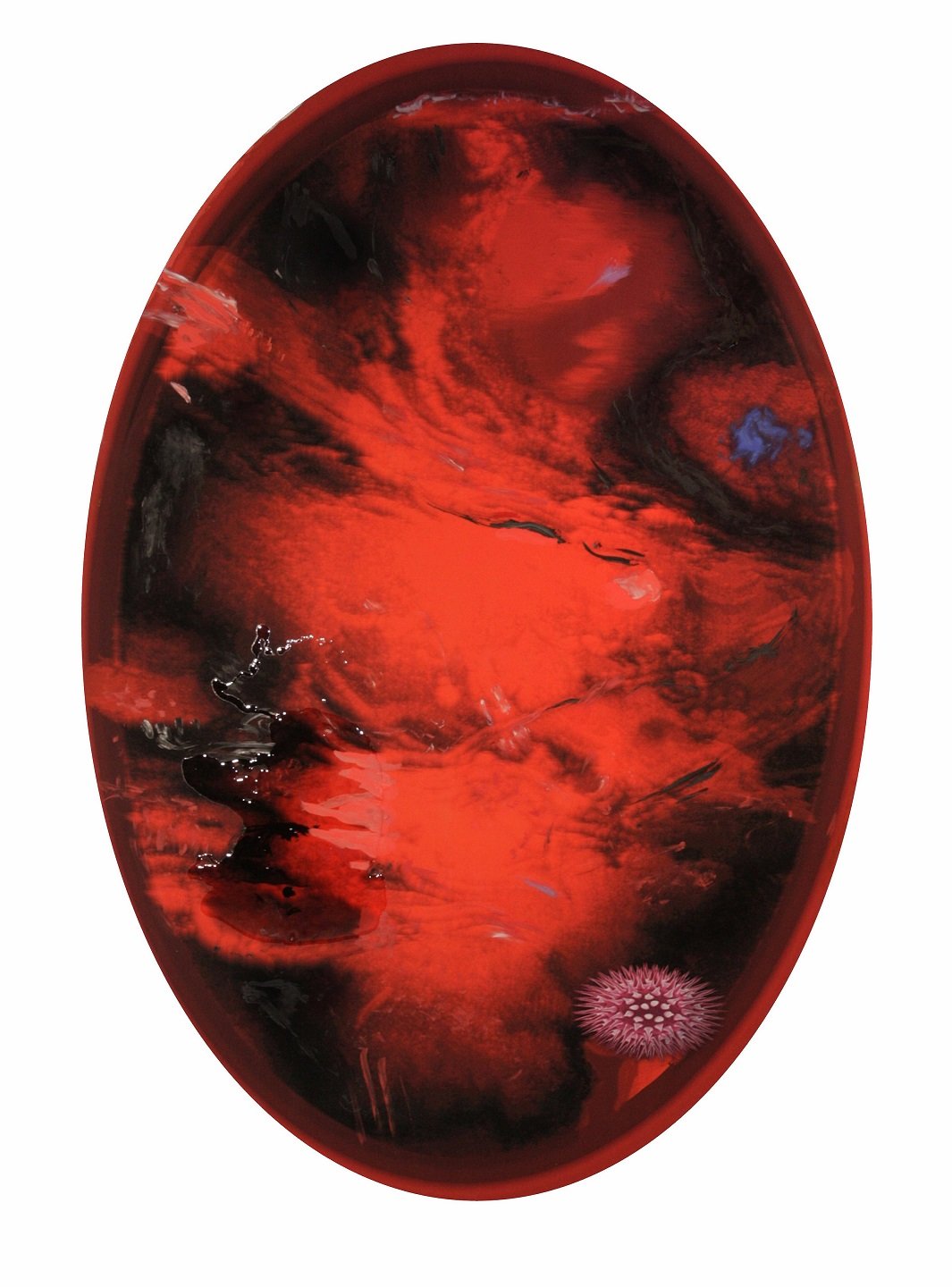
Jedd Garet, The Most Beautiful French Actress in Red Chiffon, 2015.
Photo: Courtesy the artist and C24 Gallery.
2. Jedd Garet, The Most Beautiful French Actress in Red Chiffon (2015)
Among the trend-setting artists of the 1980s, Jedd Garet created a kind of dreamlike space in his paintings populated by highly stylized figures, architectural elements, and otherworldly vegetation. For a number of personal and professional reasons, he retreated from the art scene in the 1990s and moved to California. Having recently returned to New York, he is painting in top form, as evidenced by the five commanding compositions included in a current group show, “How Many Miles to Babylon” at C24 gallery. On view through February 17, 2016, the exhibition, inaugurating C24’s new Chelsea space, was curated by Los Angeles critic and curator Peter Frank.
In his new work, Garet explores a similarly personal and imaginative space as in his earlier paintings, but this time the imagery seems more closely connected to digital realms; and his process encompasses a combination of computer programming and subtle hand-manipulated gestures and embellishments. One of the most striking on view, The Most Beautiful French Actress in Red Chiffon (2015), is a human-scale (six-feet tall) oval canvas with a fiery red ground, and swirling waves of liquids or gasses as might appear on Jupiter or Saturn. An anemone-like life form in the lower right of the piece assigns this fantastic space to a more earthly domain.
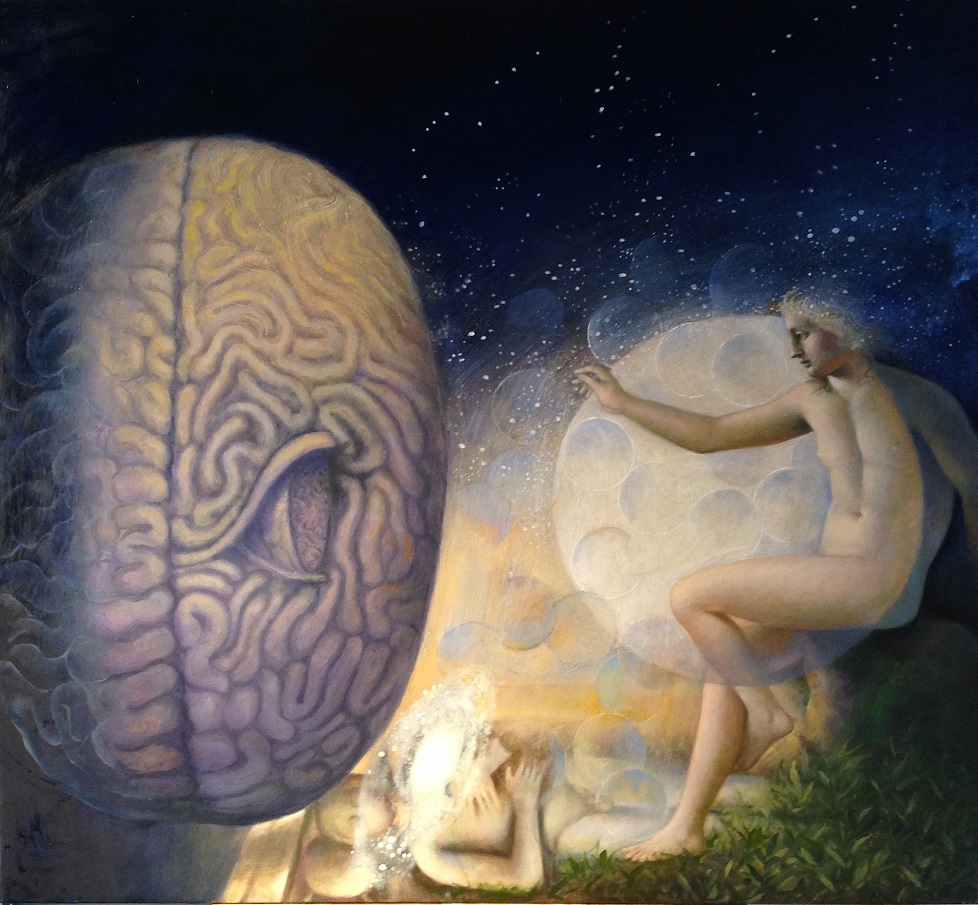
Carlo Maria Mariani, Pellegrino Fastastico (The Traveler of Fantasy), 2015.
Photo Courtesy Carlo Maria Mariani Studio.
3. Carlo Maria Mariani, Pellegrino Fantastico (The Traveler of Fantasy) (2015)
Renowned for his classically nuanced figuration, Italian-born New York-based artist Carlo Maria Mariani presented work at the National Academy of Art in New York earlier this year, where he featured an astonishing self-portrait standing behind a rather deconstructed statue of Venus. While he continues a lifelong exploration of classical allegory, Mariani’s main focal point lately is the development of a new phantasmagorical realm. In his latest works, the dapper octogenarian suggests a personal journey toward transcendental enlightenment achieved by means of the act of painting itself.
In one of his most recent works, Pellegrino Fantastico (The Traveler of Fantasy), 2015, Mariani attempts a visualization of cosmic energy as a source of artistic inspiration. On the left, the eye emerges from the brain (that of the artist, perhaps), in the process of conceptualizing a painting featuring a life-and-death allegory. That lyrical narrative is played out by the classical figures on the right, including a seated male nude triumphing over death, symbolized by the earthbound tombstone-like figure lying at his feet below. The work may appear Surrealist inspired, but Mariani has always insisted that unlike the Surrealists, his work centers on an exploration of consciousness, rather than the unconscious.
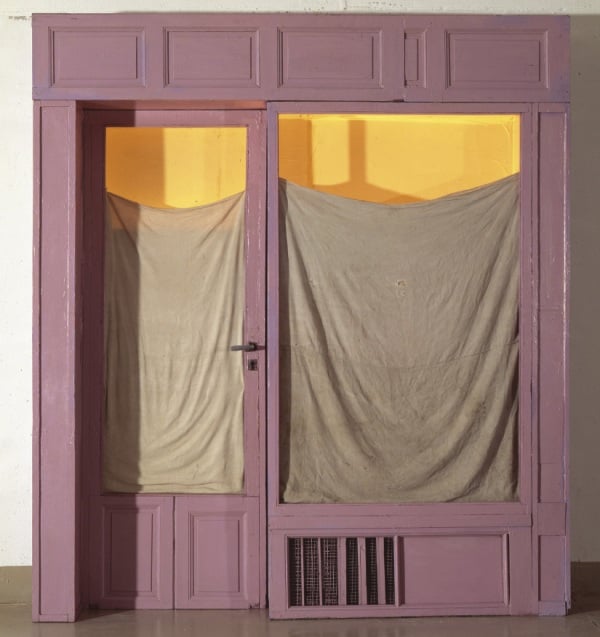
Christo, Purple Store Front,1964.
Photo: Wolfgang Volz; Courtesy Craig F. Starr Gallery. ©Christo
4. Christo, Purple Store Front (1964)
What is going on behind this life-size purple-painted storefront created by Christo in 1964? It was included in his first New York solo show, at Leo Castelli Gallery in 1966, and now reappears in New York fifty years later. It is currently one of the highlights of “Christo: Show Windows and Store Fronts, 1963-67,” at Craig F. Starr Gallery, on view in New York through January 23, 2016. As an historical work, Purple Store Front is both iconic and monumental, though it remains as fresh and mysterious as ever.
Christo, of course, became famous for the vast outdoor, environmental pieces created later, in collaboration with his late wife Jeanne-Claude. But the genesis of his concept and vision are reflected in the works on view in this striking show, which includes sculptures and collage studies for other Store Front pieces. As one stands before Purple Store Front, the imagination runs wild with all sorts of speculation and anticipation as to the secret activities that go on behind this shrouded entryway. It still beckons and repels at once, surely exactly as Christo had in mind all those years ago.
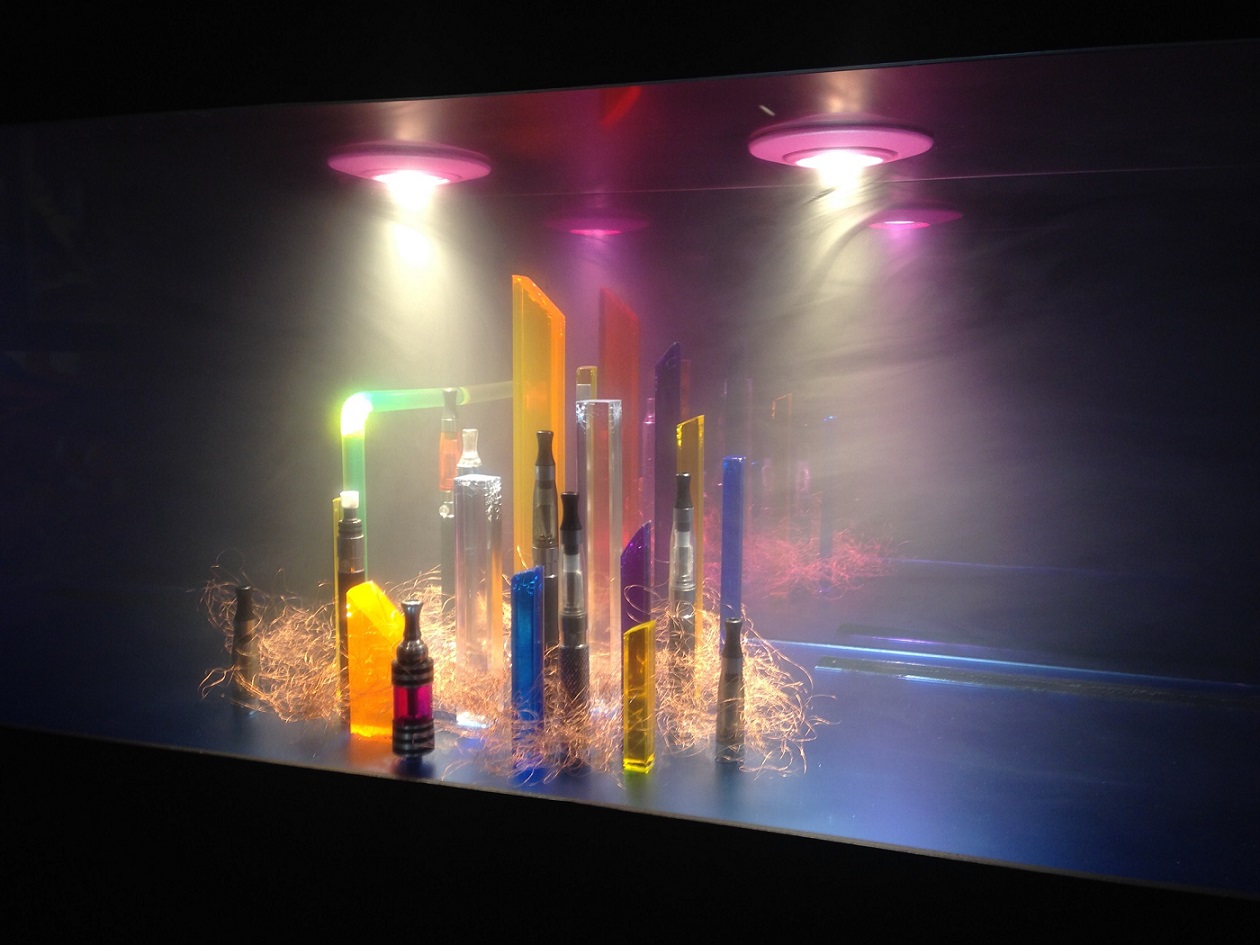
Ajay Kurian, Comfort Zone #3 (Heaven is for smokers and non-smokers), 2014.
Photo: Courtesy MoMA PS1.
5. Ajay Kurian, Comfort Zone #3 (Heaven is for smokers and non-smokers) (2014)
The artist’s misty and mystical sculptural installations are among the strongest works in “Greater New York,” an otherwise uneven show on view at MoMA PS1 through March 7, 2016. Kurian’s colorful works literally glow from within, ensconced in a black-painted room, along with works by Peter Saul, Sue Williams, Jamian Juliano-Villani, and William Viallongo; it is easily the most striking gallery in the entire exhibition.
Kurain’s Comfort Zone #3 (Heaven is for smokers and non-smokers) looks like a vitrine in a natural history museum. I spent a long time with this piece, trying to figure out what exactly it is, how it works, and why it exists. The young, New York artist placed behind a clear glass window clusters of colorful plastic tube-like cylinders on a spot-lit shelf embedded in the wall. A fog machine produces billowing translucent clouds that periodically engulf the cylinders, which prove to be various types of electronic cigarettes. I’m still not sure what Kurian is saying here, or where he is going with this idea, but it is certainly one of the most adventurous pieces in the show, and among the year’s most haunting artworks.
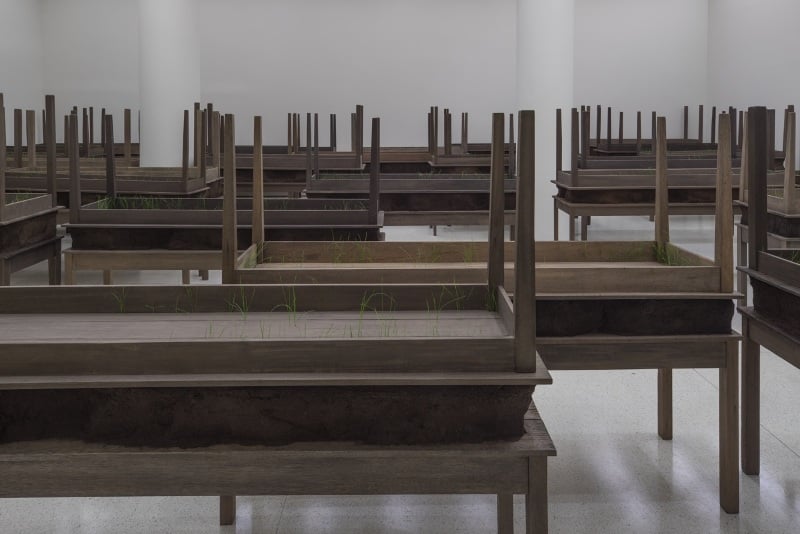
Installation view, “Doris Salcedo,” 2015, showing detail of Plegaria Muda, 2008-2010.
Photo David Heald © Solomon R. Guggenheim Foundation.
6. Doris Salcedo, Plegaria Muda (2008-2010)
I try to avoid over-used expressions like “achingly beautiful,” but I can hardly think of a better way to describe Doris Salcedo’s stunning and elegiac retrospective that appeared at the Guggenheim Museum in New York this year. The show originated at the Museum of Contemporary Art, Chicago, and travels to the Pérez Art Museum Miami, opening May 6, 2016. In her sculptures and installations, the Colombian artist alters ordinary domestic furniture and found antique pieces to create subtle yet potent metaphors for violence, and tributes to innocent victims of war, street crimes, and mass killings. The work could hardly be more relevant.
One of the most riveting and moving pieces in the show, whose title alludes to a quiet prayer, is Plegaria Muda, 2008-2010; the installation filled one large gallery. Pairs of identical long tables, with one face down atop the other, are separated by thick layers of earth. Tiny holes in the wood allow for blades of real grass to grow tall during the course of the exhibition, as the room is illuminated with softly glowing plant lights. This installation conjures a gravesite, and, like many others on view, refers to absence, and the pain of loss. Specifically in this work, Salcedo was responding to the murder of young people by government militias and gang violence.
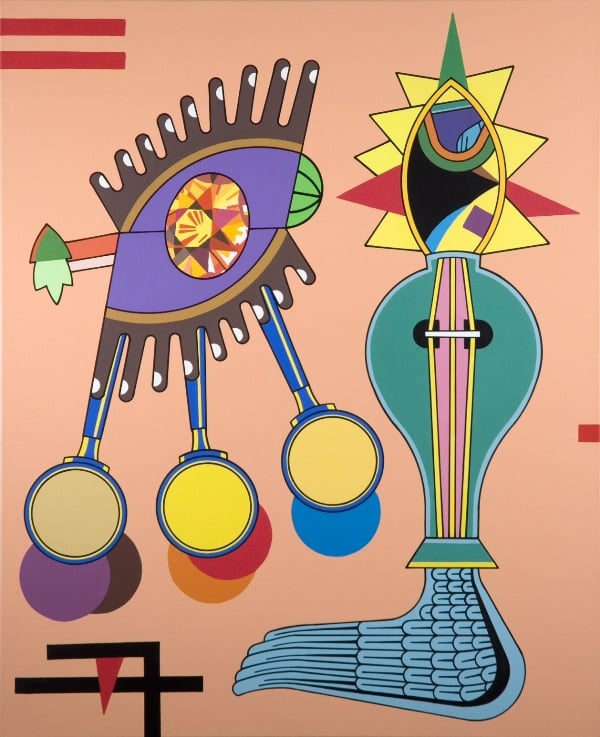
Trevor Winkfield, Duet, 2012.
Photo: Courtesy Morgan Lehman Gallery.
7. Trevor Winkfield, Duet (2012)
The year in art started out for me in early January with Duet (2012) by Trevor Winkfield, the stand-out painting in “Rough Cut,” a group show at Morgan Lehman in Chelsea. At approximately two-and-a-half- by just over three-feet, it’s not a large canvas, but it’s a particularly sumptuous example of the artist’s work. In his distinctive abstract language, the English-born New York writer and painter suggests two rather uncanny personages rendered as hard-edge geometric forms in a kaleidoscope range of colors set against a fleshy salmon background. The main elements here seem engaged in intellectual discourse—a symbolic exchange of high-minded concepts, no doubt.
In an unusual display, Winkfield hung beside the painting an identical composition in collage, created slightly earlier. It was a clear demonstration of his painstaking working method, in which he starts with the work on paper, and then transcribes the collage elements onto painted canvas. Winkfield’s process, as well as an overview of his collaborations with writers, are the focal points of a current solo show at Poets House in New York, on view through January 9, 2016.
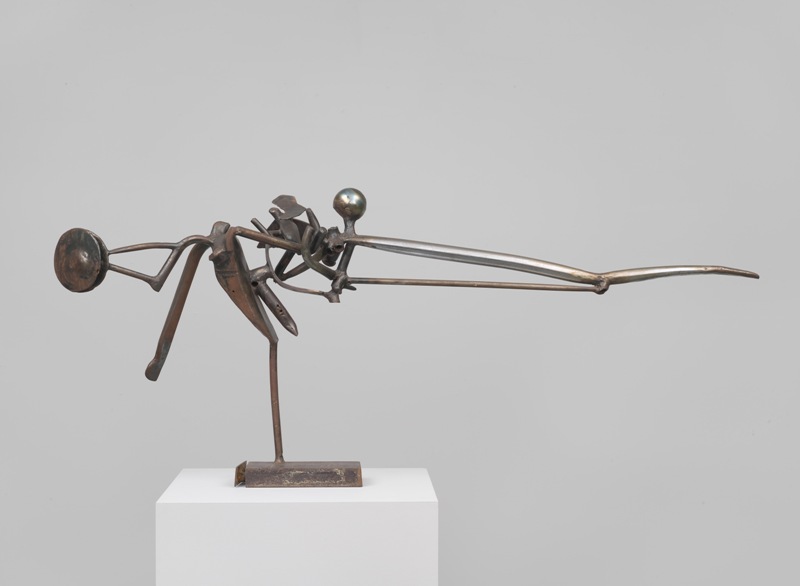
Richard Hunt, Extending Horizontal Form, 1958.
Photo © Whitney Museum of American Art.
8. Richard Hunt, Extending Horizontal Form (1958)
Celebrating his 80th birthday this year, Chicago sculptor Richard Hunt was represented in the inaugural exhibition at the new Whitney Museum last spring by his terrific welded steel sculpture Extending Horizontal Form, 1958. It was one of the more welcome surprises in “America is Hard to See,” a show featuring selections from the museum’s permanent collection. It was a surprise because until this year, the work was indeed hard to see, as the Whitney had not shown the sculpture since the 1960s; it had been unfairly relegated to storage not long after it entered the museum’s collection.
The precocious sculptor created this lively, abstract composition while still in his twenties, as he broke down barriers and smashed stereotypes that thwarted many young African American artists of the period. Yet in its power and assuredness, Hunt’s work in the Whitney show held up well with other sculptures in the room by his artistic forebears like David Smith.
Hunt went on to have an illustrious career, and continues to make evocative works today, remaining true to the abstract vision of his youth. Hopefully, Extending Horizontal Form reminds viewers that Hunt is long overdue for a major museum survey.
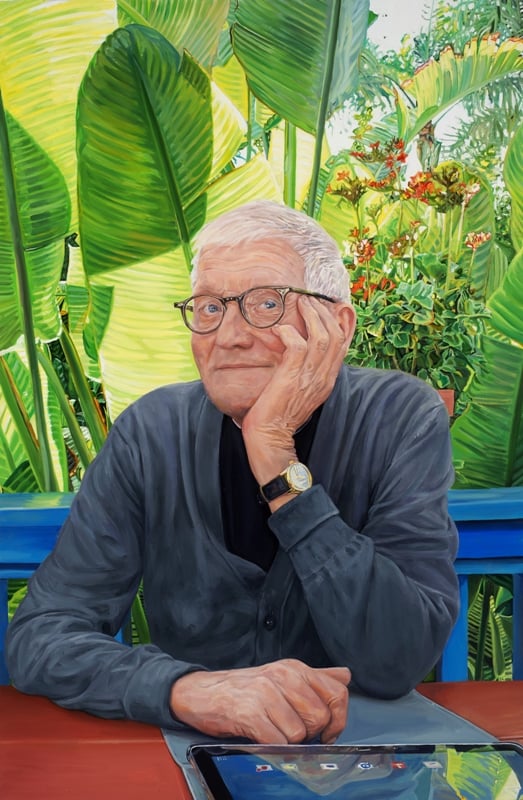
Brenda Zlamany, Portrait #139 (David Hockney), 2015.
Photo: Courtesy the artist.
9. Brenda Zlamany, Portrait of David Hockney (2015)
Some artists spend a great deal of time working outside the gallery system or other conventional art world platforms, and still manage to bring attention to their works in novel ways. For some years, New York painter Brenda Zlamany has been using social media and word-of-mouth to receive recognition for her significant talents as a portraitist. A Fulbright grant last year enabled her to embark on an ambitious project to paint 365 portraits, one per day for a year, which she began while living in Taiwan, focusing on the aboriginal tribes of Han ancestry who still live in rural villages.
Zlamany continued the project after her return to New York, focusing on friends, neighbors and art world denizens. I learned about the extent of her project and her dedication to this endeavor only while sitting for one of her watercolor portraits, as part of the project. Her meticulous craftsmanship is evident in all of her works, as is the ability to capture some special inner light that makes each of her subjects unique. She is at her best in works such as the study of her longtime friend, Portrait #139 (David Hockney), 2015, hanging in her studio. A related portrait of Hockney by Zlamany will be featured in a group show at the National Portrait Gallery in Washington, DC, opening March 12, 2016.
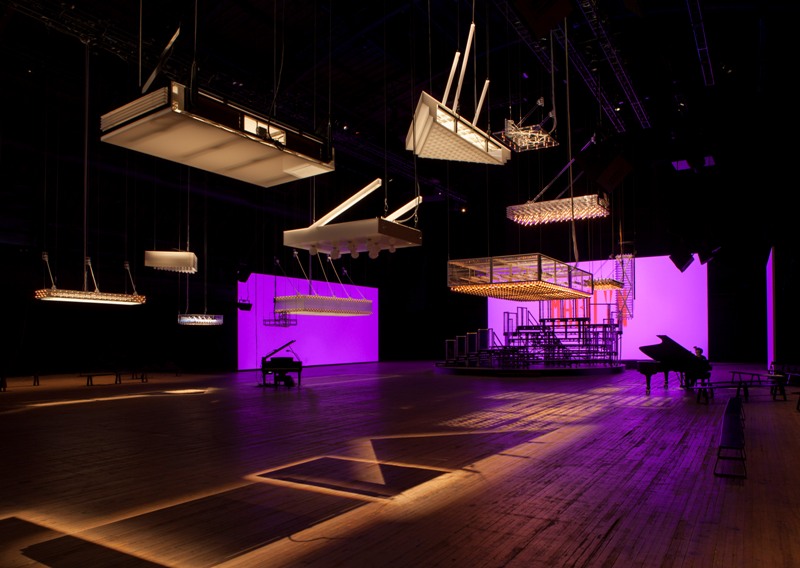
Philippe Parreno, Exhibition view H {N)Y P N(Y} OSIS, Park Avenue Armory, 2015.
Photo Andrea Rossetti; Courtesy Park Avenue Armory © Philippe Parreno.
10. Philippe Parreno, H{N)Y P N(Y} OSIS (2015)
If contemporary art has a subgenre, “art as spectacle,” Philippe Parreno’s mind-bending, marathon extravaganza, H{N)Y P N(Y} OSIS (pronounced hypnosis) must certainly represent one of the most breathtaking examples of the year. Unfolding last summer in the vast space of the Park Avenue Armory’s Drill Hall, the Paris-based artist’s ambitious endeavor featured an elaborate array of sculptures, installations, film pieces, and continuous live performances in which the audience participated in a number of ways. It sometimes had the feel of a three-ring circus, or an arty version of “Fuerza Bruta,” but Parreno’s focus was more intense, and the rewards were many. For the price an ordinary New York movie ticket ($15), Parreno offered art audiences a daylong, truly immersive and exhilarating experience.
Loose threads of narrative connected the various disparate episodic elements in the eight-hour-plus performance/exhibition, including a pulsating light show, a video reenactment of the train carrying Robert Kennedy’s body from New York to Washington, DC, collaborations with artists such as Tino Sehgal, and live piano performances by Mikhail Rudy. It was all about the passage of time, the constant movement of the audience within the space, and audience members’ individual interactions with Parreno’s personal vision.
David Ebony is a contributing editor of Art in America and a longtime contributor to artnet.